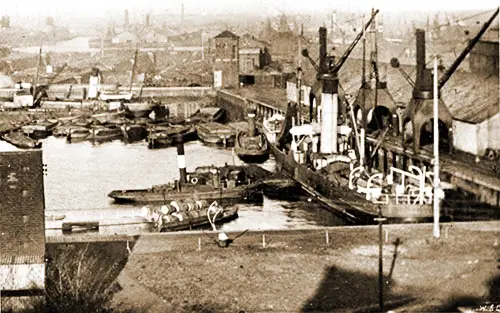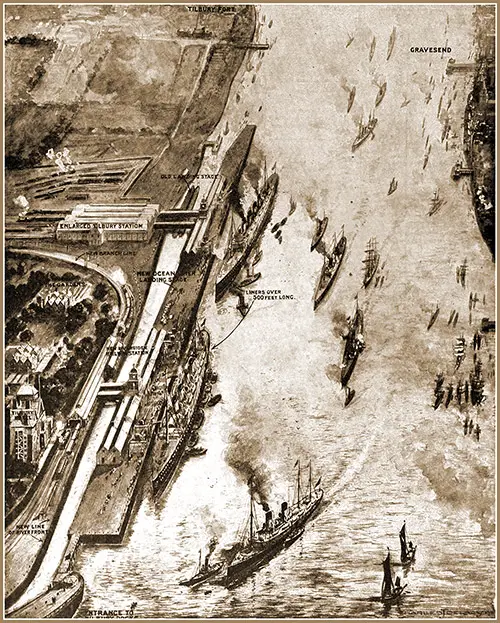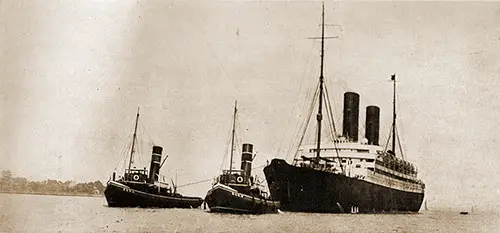London, England Passenger Lists 1879-1955

Entrance to Tilbury Docks, London in 1908. | GGA Image ID # 1765cd274e
London is the capital city of England and the United Kingdom. London was the world's largest city from about 1831 to 1925. The River Thames is navigable to ocean-going vessels as far as London Bridge, and to substantial craft well upstream of Greater London. Historically, the river was one of London's main transport arteries.
The latest announcements of several administrations have appeared since 1923. London is again at the forefront. Its largest new work will be making an entirely new dock, lock, and dry dock, and a passenger landing stage at the existing Tilbury Docks on the River Thames, seaward from London. These facilities are intended to augment the passenger-freight sailings between London and the United States. The United States Line of Shipping Board vessels and the American Lino are now using these docks. It is estimated that the cost of these projects, exclusive of land, will reach £5,000,000.
Will Passenger be Landed from Great Liners at Tilbury?
The Proposal to Improve and Extend the Dock Accommodation of London.

Somewhat on the Lines of Prince's Landing-Stage at Liverpool: The Suggested Passenger Landing-Place for Ocean-going Steamers at Tilbury. Drawn by C. J. de Lacy. The Illustrated London News, 25 February 1911, p. 277. | GGA Image ID # 1d40ba8ea5
Among the numerous plans for bettering the Port of London by improving and extending the dock, accommodation is a proposal, fathered by Lord Devonport, the Chairman of the Port of London Authority, and its chief engineer, Mr. F. Palmer, to construct ac Tilbury a passenger landing-place for ocean-going steamers, somewhat on the lines of Prince's Landing-stage at Liverpool.
Our drawing, based on Mr. Palmer's designs, illustrates the suggestion. one may note, further, that at the moment, London has no dock large enough to accommodate the more giant ocean liners, such as the "Mauretania" or the "Lusitania," The conveniences of Tilbury for such a purpose are apparent. Passengers landing there could reach London from thirty-five to forty-five minutes.
One may also point out that in the last twenty-five years, the shipping using the Port of London has grown from a net register tonnage of under twelve million to over eighteen million. Lord Devon port is sanguine that this growth will continue concerning the amount of trade and the size of vessels.
Passenger Lists Calling at the Port of London
1870s - 1890s
Anchor Steamship Line
Atlantic Transport Line
Orient Line
1900s
Atlantic Transport Line
- 1900-09-15 SS Marquette - New York for London
- 1900-11-08 SS Marquette - London to New York
- 1902-04-10 SS Minneapolis - London to New York
- 1902-08-16 SS Minnehaha - London to New York
- 1904-06-18 SS Minnetonka - London to New York
- 1904-08-27 SS Minneapolis - London to New York
- 1904-09-03 SS Mesaba - London to New York
- 1905-09-30 SS Minneapolis - New York to London
- 1905-11-16 SS Minneapolis - London to New York
- 1906-05-12 SS Minneapolis - London to New York
- 1908-07-25 SS Minnetonka - London to New York
- 1909-06-12 SS Minneapolis - London to New York
1910s
Atlantic Transport Line
1920s
Aberdeen Line
American Merchant Lines
Atlantic Transport Line
- 1924-05-31 SS Minnewaska - New York to London
- 1925-07-11 SS Minnekahda - London to New York
- 1925-08-08 SS Minnekahda - London to New York
- 1927-04-23 SS Minnewaska - London to New York
- 1927-06-11 SS Minnesota - New York to London
- 1927-08-20 SS Minnesota - London to New York
- 1927-09-03 SS Minnekahda - London to New York
- 1927-10-15 SS Minnesota - London to New York
- 1927-12-17 SS Minnetonka - Tilbury (London) to New York
- 1928-03-31 SS Minnekahda - London to New York
- 1928-06-23 SS Minnekahda - London to New York
- 1928-07-07 SS Minnesota - London to New York
- 1928-07-21 SS Minnekahda - London to New York
- 1928-08-04 SS Minnesota - London to New York
- 1928-08-25 SS Minnewaska - London to New York
- 1928-09-01 SS Minnesota - London to New York
- 1929-10-12 SS Minnewaska - Tilbury (London) for New York
Cunard Line
Red Star Line
Royal Mail Steam Packet Company (R.M.S.P.)
Union-Castle Line
United States Lines
White Star Line
1930s
American Merchant Lines
Atlantic Transport Line
Canadian Pacific Line
Cunard Line
Royal Mail Lines
Union-Castle Line
White Star Line
1940s
Cunard Line
1950s
Peninsular & Oriental Line (P&O)
Union-Castle Line
Note: Typically, only the origination and final destination ports are listed in each link. Other intermediary ports of call are not listed.

The SS Caronia docking near the Tilbury Docks in London circa 1923. | GGA Image ID # 1766a7fbe7
Tilbury is a town in the borough of Thurrock, Essex, England. As a settlement it is of relatively recent existence, although it has important historical connections, being the location of a 16th-century fort and an ancient cross-river ferry. It is also the location of a modern deep-water port.
Port of London is Great Britian's link with Empire both for passengers and merchandise. Goods worth nearly £500,000,000 pass yearly through the docks, over a third of their entire overseas trade. P.L.A. Docks cover an area of 4,247 acres and have 45 miles of quays.
Tilbury provides the first P.L.A. docks as vessels approach from sea, with an area of 725 acres and 4 miles a quays. Vessels using them trade principally with Australia, New Zealand, India and the Far East.
Unsurpassed facilities for passengers, hundres of thousands arriving and departing every year. Landing Stage of 1,142 feet long enables liners to be accommodated during any state of tide.
The King George V Dock, the most modern in London, was opened by King George in 1921.
Related Categories
Ephemera & History
- Aberdeen Line
- American Merchant Lines
- Anchor Steamship Line
- Atlantic Transport Line
- Canadian Pacific Line
- Cunard Line
- Orient Line
- Peninsular & Oriental Line (P&O)
- Red Star Line
- Royal Mail Lines
- Royal Mail Steam Packet Company (R.M.S.P.)
- Union-Castle Line
- United States Lines
- White Star Line
Steamship & Ocean Liners
- Alaunia
- Albertic
- American Farmer
- American Merchant
- American Shipper
- American Trader
- Ascania
- Asturias
- Aurania
- Belgenland
- California
- Carinthia
- Edinburgh Castle
- Georgic
- Llandaff Castle
- Marquette
- Mesaba
- Minneapolis
- Minnehaha
- Minnekahda
- Minnesota
- Minnetonka
- Minnewaska
- Montcalm
- Orduña
- Orient
- Orion
- President Garfield
- President Monroe
- President Van Buren
- Samaria
- Sophocles
- Strathmore
- Tuscania
- Windsor Castle
Ports of Call Information
By Year of Voyage
- 1879
- 1899
- 1900
- 1902
- 1904
- 1905
- 1906
- 1908
- 1909
- 1912
- 1913
- 1914
- 1922
- 1923
- 1924
- 1925
- 1927
- 1928
- 1929
- 1930
- 1931
- 1932
- 1933
- 1934
- 1935
- 1936
- 1938
- 1939
- 1947
- 1949
- 1954
- 1955
By Port of Call
- Adelaide
- Albany
- Boston
- Brisbane
- Buenos Aires
- Cape Town
- Casablanca
- Gibraltar
- Lisbon
- London (Tilbury)
- Madeira
- Melbourne
- Montréal
- Natal
- New York
- Québec
- Southampton
- Sydney
- Australian
- Canadian
- South African
SS RMS MV - Defined
⚠️ About Accuracy in Historical Records Research Tip
Context. The GG Archives presents passenger lists as faithfully as possible to the original documents. While OCR is generally accurate, portions of these collections—especially image captions and some transcriptions—are typed by hand and may include typographical or spelling variations. The original manifests themselves also contained clerical inconsistencies (names recorded phonetically, mid-voyage corrections, etc.).
What this means for your research:
- Search variant spellings of names (e.g., “Schmidt/Schmitt/Smith,” “Giuseppe/Joseph”).
- Cross-reference with immigration cards, passport applications, naturalization files, city directories, and newspapers.
- Treat manifests as primary sources with historical quirks—use them alongside corroborating records.
- For place names, consider historical borders and language variants (e.g., Danzig/Gdańsk, Trieste/Trst).
How to cite. When quoting a name from a manifest, consider adding [sic] for obvious misspellings and include a note such as “spelling as printed in original passenger list.”
Need help? If you spot a likely transcription error in captions, feel free to contact us with the page URL and a brief note—we love community input. 🙏
Curator’s Note
For over 25 years, I've been dedicated to a unique mission: tracking down, curating, preserving, scanning, and transcribing historical materials. These materials, carefully researched, organized, and enriched with context, live on here at the GG Archives. Each passenger list isn't just posted — it's a testament to our commitment to helping you see the people and stories behind the names.
It hasn't always been easy. In the early years, I wasn't sure the site would survive, and I often paid the hosting bills out of my own pocket. But I never built this site for the money — I built it because I love history and believe it's worth preserving. It's a labor of love that I've dedicated myself to, and I'm committed to keeping it going.
If you've found something here that helped your research, sparked a family story, or just made you smile, I'd love to hear about it. Your experiences and stories are the real reward for me. And if you'd like to help keep this labor of love going, there's a "Contribute to the Website" link tucked away on our About page.
📜 History is worth keeping. Thanks for visiting and keeping it alive with me.
